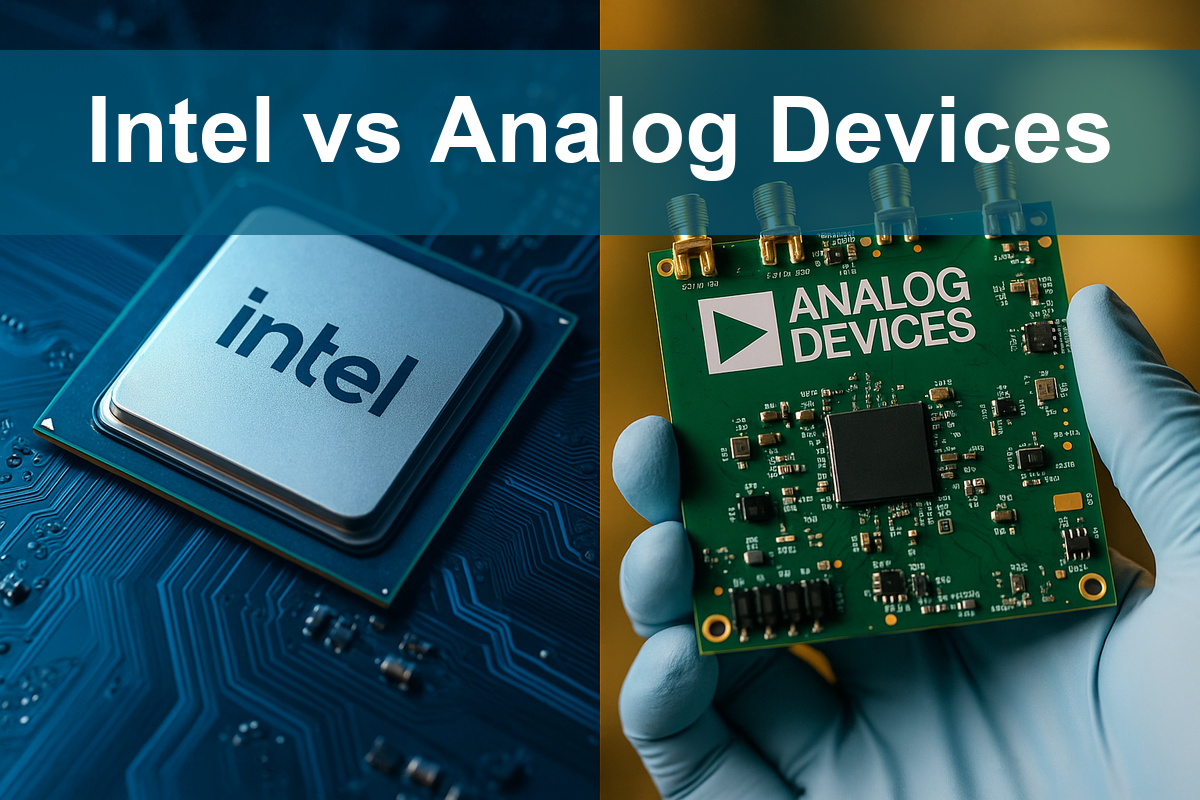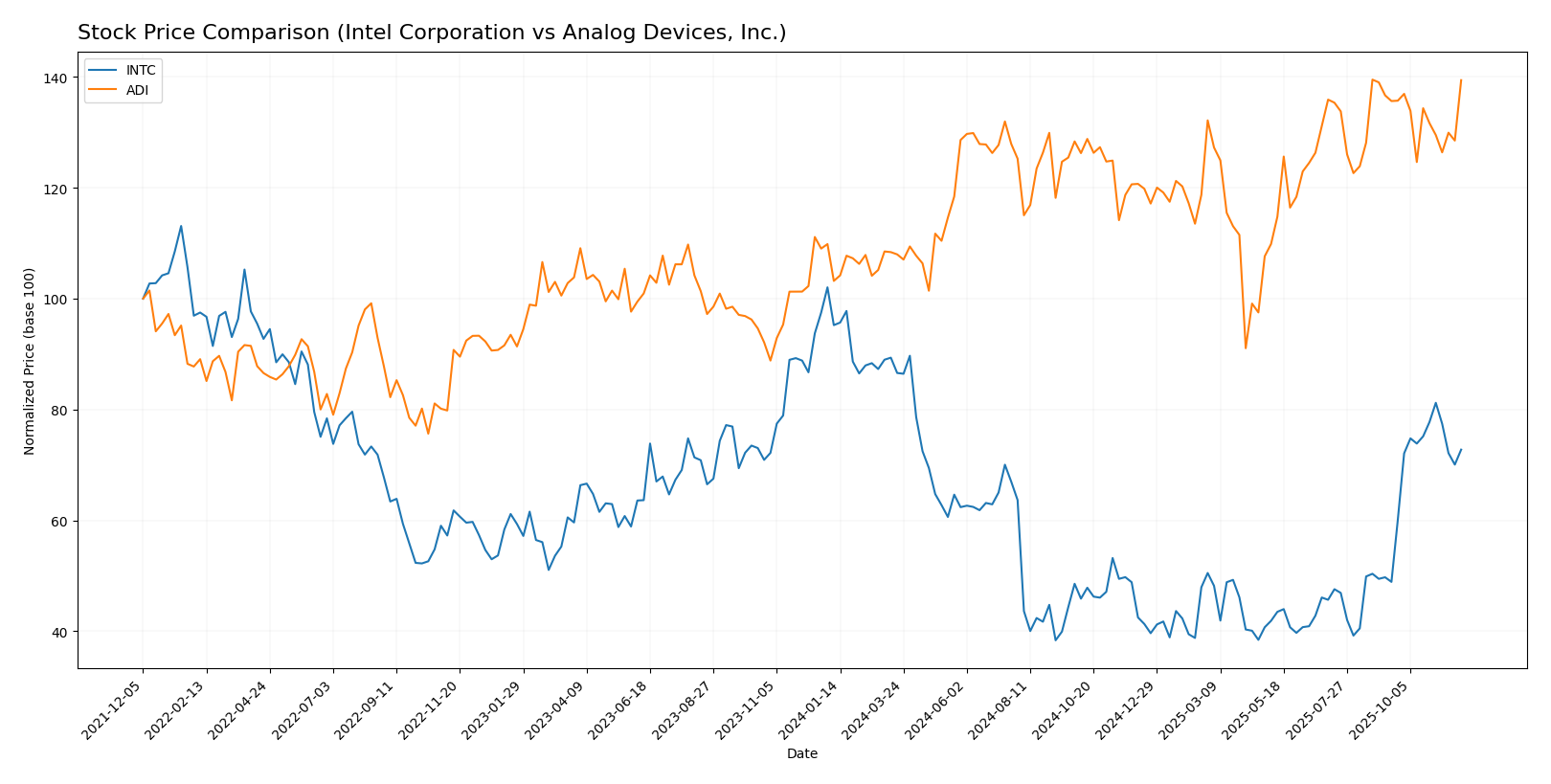In the fast-paced world of semiconductors, two giants stand out: Intel Corporation (INTC) and Analog Devices, Inc. (ADI). Both companies operate within the same industry yet pursue different innovation strategies and market segments. As they navigate an increasingly competitive landscape, understanding their unique strengths and weaknesses is vital for savvy investors. In this article, I will help you determine which company presents the most compelling investment opportunity.

Table of contents
Company Overview
Intel Corporation Overview
Intel Corporation (Ticker: INTC), founded in 1968 and headquartered in Santa Clara, California, is a global leader in semiconductor technology. The company designs, manufactures, and sells a wide array of computer products including central processing units (CPUs) and system-on-chip solutions. With a market cap of approximately $178.4B, Intel operates across multiple segments such as Client Computing, Data Center, and Internet of Things, focusing on high-performance compute solutions. Its commitment to innovation is evident through strategic partnerships aimed at advancing artificial intelligence and cloud computing technologies. The company also plays a pivotal role in the development of autonomous driving technologies, catering to various industries including healthcare, retail, and industrial applications.
Analog Devices, Inc. Overview
Analog Devices, Inc. (Ticker: ADI), incorporated in 1965 and based in Wilmington, Massachusetts, specializes in designing and manufacturing integrated circuits and subsystems that leverage analog and digital signal processing technologies. With a market capitalization of around $131.2B, Analog Devices serves a diverse range of sectors, including automotive, communications, and industrial markets. The company is recognized for its innovative data converters and power management solutions, which are essential for converting real-world signals into digital data and vice versa. Its ongoing commitment to high-performance technology positions Analog Devices as a key player in the semiconductor industry, especially in applications requiring precision and reliability.
Key similarities and differences
Both Intel and Analog Devices operate within the semiconductor industry, focusing on high-performance technology solutions. However, while Intel emphasizes CPU and computing solutions, Analog Devices concentrates on mixed-signal and analog components. Additionally, Intel’s broader market reach includes cloud service providers, whereas Analog Devices targets specialized sectors like automotive and industrial applications.
Income Statement Comparison
The table below provides a snapshot of the income statements for Intel Corporation (INTC) and Analog Devices, Inc. (ADI), highlighting key financial metrics for the most recent fiscal year.
| Metric | Intel Corporation (INTC) | Analog Devices, Inc. (ADI) |
|---|---|---|
| Market Cap | 178.38B | 131.18B |
| Revenue | 53.10B | 11.02B |
| EBITDA | 1.20B | 5.03B |
| EBIT | -10.18B | 3.03B |
| Net Income | -18.76B | 2.27B |
| EPS | -4.38 | 4.56 |
| Fiscal Year | 2024 | 2025 |
Interpretation of Income Statement
In the most recent fiscal year, Intel (INTC) experienced significant revenue decline to 53.10B, down from 63.05B in 2022, resulting in a net loss of 18.76B due to rising operational costs and challenges in the semiconductor market. Conversely, Analog Devices (ADI) reported strong growth with revenue increasing to 11.02B and net income of 2.27B, showcasing improved operational efficiency and solid demand for its products. The contrasting trends in margins and profitability highlight Intel’s ongoing struggles, while ADI demonstrates resilience and robust performance in its sector.
Financial Ratios Comparison
In this section, I provide a comparative analysis of the most recent revenue and key financial ratios for Intel Corporation (INTC) and Analog Devices, Inc. (ADI).
| Metric | Intel Corporation (INTC) | Analog Devices, Inc. (ADI) |
|---|---|---|
| ROE | -19% | 6.7% |
| ROIC | -12.2% | 5.6% |
| P/E | -4.63 | 51.05 |
| P/B | 0.88 | 3.42 |
| Current Ratio | 1.33 | 2.19 |
| Quick Ratio | 0.98 | 1.68 |
| D/E | 0.50 | 0.25 |
| Debt-to-Assets | 25% | 18% |
| Interest Coverage | -14.17 | 9.45 |
| Asset Turnover | 0.27 | 0.23 |
| Fixed Asset Turnover | 0.49 | N/A |
| Payout Ratio | -8.5% | 84.9% |
| Dividend Yield | 1.84% | 1.66% |
Interpretation of Financial Ratios
The analysis shows that Intel is currently struggling, as reflected by negative returns on equity (ROE) and investment capital (ROIC), indicating operational challenges. In contrast, Analog Devices demonstrates stronger profitability and efficiency metrics, notably a positive ROE and a significantly high dividend payout ratio. However, ADI’s higher P/E ratio suggests that the stock may be overvalued, warranting caution for potential investors.
Dividend and Shareholder Returns
Intel Corporation (INTC) pays dividends, with a current yield of 1.84% and a payout ratio exceeding 100%, indicating potential sustainability risks. Despite share buybacks, free cash flow challenges raise concerns about future distributions. Conversely, Analog Devices, Inc. (ADI) also distributes dividends (yielding 2.08%) alongside a strategic share buyback program. Both companies’ approaches suggest a commitment to returning value to shareholders, but I advise caution regarding Intel’s payout sustainability.
Strategic Positioning
In the semiconductors sector, Intel Corporation (INTC) holds a significant market share with a market cap of $178.4B, focusing on a diverse range of products including CPUs and AI solutions. Conversely, Analog Devices, Inc. (ADI) has a market cap of $131.2B, specializing in data converters and power management technologies. Both companies face competitive pressure from emerging players and must adapt to rapid technological disruptions, particularly in AI and IoT, to maintain their market positions.
Stock Comparison
In examining the weekly stock price movements of Intel Corporation (INTC) and Analog Devices, Inc. (ADI), we observe significant fluctuations and trading dynamics that define their current market positions over the past year.

Trend Analysis
Intel Corporation (INTC) has experienced a price change of -13.5% over the past year, indicating a bearish trend. The overall trend shows acceleration, with a standard deviation of 8.53, suggesting notable volatility. The stock has seen highs of 48.15 and lows of 18.89, reflecting a challenging trading environment.
In the recent analysis from September 14, 2025, to November 30, 2025, INTC’s price increased by 68.44%. However, the stock shows signs of acceleration in this recent period, with a standard deviation of 4.39.
Analog Devices, Inc. (ADI), on the other hand, has reported a robust price change of 42.24% over the last year, affirming a bullish trend despite recent deceleration. The standard deviation of 19.28 indicates higher volatility in comparison to INTC. The stock peaked at 265.34 and reached a low of 164.6, showcasing a healthy growth trajectory.
From September 14, 2025, to November 30, 2025, ADI has shown an 8.21% price increase, though the trend slope suggests recent deceleration with a standard deviation of 10.16.
Analyst Opinions
Recent analyst recommendations for Intel Corporation (INTC) indicate a cautious stance, with a rating of C+. Analysts highlight concerns over its return on equity and price-to-earnings ratios as significant red flags. In contrast, Analog Devices, Inc. (ADI) received a more favorable rating of B, supported by strong discounted cash flow and return on assets scores. The consensus for ADI leans towards a buy, whereas INTC’s outlook suggests a hold position. Overall, I recommend considering ADI for a more promising investment opportunity.
Stock Grades
In the current market landscape, here are the latest stock grades for Intel Corporation and Analog Devices, Inc., provided by reputable grading companies.
Intel Corporation Grades
| Grading Company | Action | New Grade | Date |
|---|---|---|---|
| Tigress Financial | maintain | Buy | 2025-11-04 |
| Barclays | maintain | Equal Weight | 2025-10-27 |
| Morgan Stanley | maintain | Equal Weight | 2025-10-24 |
| Rosenblatt | maintain | Sell | 2025-10-24 |
| Truist Securities | maintain | Hold | 2025-10-24 |
| Wells Fargo | maintain | Equal Weight | 2025-10-24 |
| Wedbush | maintain | Neutral | 2025-10-24 |
| JP Morgan | maintain | Underweight | 2025-10-24 |
| TD Cowen | maintain | Hold | 2025-10-24 |
| Needham | maintain | Hold | 2025-10-24 |
Analog Devices, Inc. Grades
| Grading Company | Action | New Grade | Date |
|---|---|---|---|
| Morgan Stanley | maintain | Overweight | 2025-11-26 |
| JP Morgan | maintain | Overweight | 2025-11-26 |
| Evercore ISI Group | maintain | Outperform | 2025-11-26 |
| Benchmark | maintain | Buy | 2025-11-26 |
| B of A Securities | maintain | Buy | 2025-11-26 |
| Baird | maintain | Outperform | 2025-11-26 |
| Wells Fargo | maintain | Equal Weight | 2025-11-26 |
| Truist Securities | maintain | Hold | 2025-11-26 |
| Cantor Fitzgerald | maintain | Overweight | 2025-09-30 |
| Benchmark | maintain | Buy | 2025-08-21 |
Overall, both companies have maintained stable ratings, with Intel showing a mix of “Buy,” “Hold,” and “Sell” sentiments, while Analog Devices generally receives more favorable “Overweight” and “Buy” ratings. This suggests a more positive outlook for Analog Devices compared to Intel at this time.
Target Prices
The current consensus target prices for Intel Corporation (INTC) and Analog Devices, Inc. (ADI) reflect optimistic forecasts from analysts.
| Company | Target High | Target Low | Consensus |
|---|---|---|---|
| Intel Corporation | 52 | 20 | 35.22 |
| Analog Devices, Inc. | 300 | 258 | 283.58 |
For Intel, the consensus target price is 35.22, which is below its current price of 40.56, indicating a potential downside. Conversely, Analog Devices has a consensus target of 283.58, suggesting a strong upside from its current price of 265.34.
Strengths and Weaknesses
The following table outlines the strengths and weaknesses of Intel Corporation (INTC) and Analog Devices, Inc. (ADI) based on their recent performance metrics.
| Criterion | Intel Corporation (INTC) | Analog Devices, Inc. (ADI) |
|---|---|---|
| Diversification | Moderate | High |
| Profitability | Low (Net Margin: 3.11%) | High (Net Margin: 26.94%) |
| Innovation | Moderate | High |
| Global presence | High | High |
| Market Share | Moderate | Strong |
| Debt level | Moderate (Debt/Equity: 0.47) | Low (Debt/Equity: 0.25) |
Key takeaways: Intel’s profitability is currently low, reflecting ongoing challenges, while Analog Devices shows strong financial health and innovation. Diversification and global presence are strengths for both companies, but ADI has a notable edge in profitability and debt management.
Risk Analysis
Below is a summary of the key risks associated with Intel Corporation (INTC) and Analog Devices, Inc. (ADI).
| Metric | Intel Corporation (INTC) | Analog Devices, Inc. (ADI) |
|---|---|---|
| Market Risk | High | Moderate |
| Regulatory Risk | Moderate | Low |
| Operational Risk | High | Moderate |
| Environmental Risk | Moderate | Low |
| Geopolitical Risk | High | Moderate |
Both companies face considerable risks, particularly market and operational risks. Intel’s recent challenges in product competitiveness and geopolitical tensions in semiconductor supply chains heighten its risk profile. Conversely, Analog Devices exhibits lower overall risk, with a stable operational framework and less exposure to regulatory pressures.
Which one to choose?
When comparing Intel Corporation (INTC) and Analog Devices, Inc. (ADI), several factors come into play. Intel’s recent financial performance indicates a bearish trend with a significant decline in net income, a C+ rating, and a P/E ratio of -4.63, suggesting challenges in profitability. Conversely, Analog Devices exhibits a bullish trend, with a B rating, strong profitability metrics, and a P/E ratio of 51.05, reflecting robust investor confidence.
For growth-oriented investors, ADI appears more favorable due to its consistent revenue growth and better profitability ratios. On the other hand, those seeking value or turnaround potential might consider INTC, albeit with caution due to its ongoing restructuring challenges and competitive pressures.
Both companies face industry risks; Intel’s market dependence and supply chain issues may hinder recovery, while Analog Devices contends with increased competition in the semiconductor space.
Disclaimer: This article is not financial advice. Each investor is responsible for their own investment decisions.
Go further
I encourage you to read the complete analyses of Intel Corporation and Analog Devices, Inc. to enhance your investment decisions:



